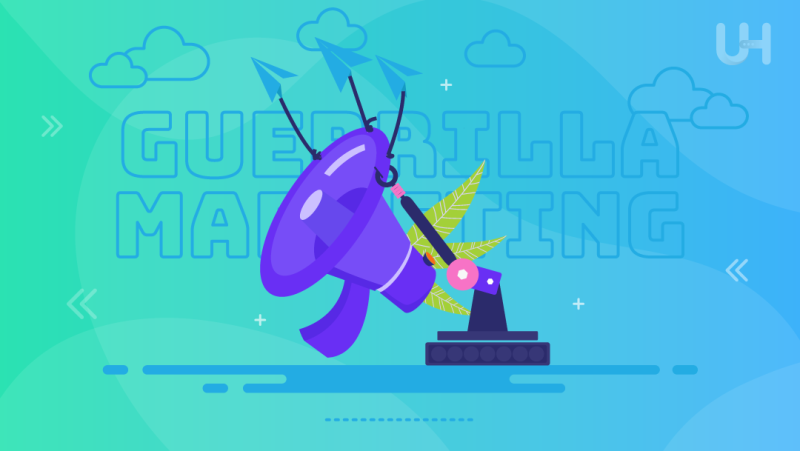Guerrilla marketing is an unconventional form of representative marketing that is really creative and pays attention to its objective of leaving an indelible mark on the audience. Instead of traditional marketing, it works around surprise, innovation, and often shock value in reaching the target audience. It seeks to create an unforgettable experience with a lasting effect on the audience’s mind and doesn’t demand a huge budget.
Companies and small businesses often use guerrilla marketing to cut through marketplace clutter. In this blog, we’ll examine guerrilla marketing’s brief history, key characteristics, and benefits, including how to design an appropriate campaign using this approach.
What Is Guerrilla Marketing?
Guerilla marketing is a promotional and creative marketing tactic that is considered a low investment and causes a high impact. A product, service, or brand is normally connected with the same. The strategy tries to stir some hype or interest in a target audience by creating surprise or some other mode of intention. This is where it stresses creativity, innovation, and interactivity rather than large budgets for advertising.
With the change in technology and media, the evolution of guerrilla marketing continued as it plunged into digital platforms, viral campaigns, and social media stunts. In some cases, brands also connect guerrilla tactics with performance-based advertising to ensure that creative efforts not only spark attention but also translate into measurable outcomes. Nowadays, both small and large companies use it in order to create a buzz and entertain through innovations in a creative manner that mingles tradition with state-of-the-art interactive features to capture the attention of audiences for lead nurturing.
Key Characteristics
- Unconventional Tactics: The strategies involved in guerrilla marketing are more innovative and unexpected, considerably meant to surprise or even shock an audience.
- Low-Budget Campaigns: Unlike conventional marketing, guerrilla marketing focuses more on creativity than having a big budget; hence, it is quite affordable for smaller businesses.
- Engaged Audience: These campaigns involve an emotional response and encourage or plead with people to take it up and share with others, usually by word of mouth or through social media.
- Integration with Technology: Guerilla marketing today embraces digital marketing, such as Facebook marketing and social network hostings platforms, to achieve greater reach and make campaigns go viral.
Types of Guerrilla Marketing Tactics
- Ambient Marketing: This refers to placing advertisements in the most unusual places-so that they should not appear common to an audience. Marketing messages are integrated into your surroundings.
- Street Marketing: Interacting with people directly, often on the busiest outdoors, this activity may take the form of flash mobs, product sampling, or interactive performances to build awareness and encourage participation.
- Experiential Marketing: This approach creates memorable and immersive experiences. It engages consumers by involving them with the brand through practical participation, often combining real-world events with social media for better visibility and reach.
Benefits of Guerrilla Marketing
- Cost-Effective: The reputation of guerrilla marketing is to create a big bang but with a small buck. It will provide an opportunity for a business, especially small ones, to create brand promotional activities in many imaginative ways without localized advertisement campaigns, which tend to be costly.
- Viral Potential: The practice of guerrilla marketing, with its surprise and uniqueness, catalyzes conversations among people and leads them to spread the word on your campaigns across social media, hence allowing the chance of messages moving virally.
- Memorable Impact: The idea of guerrilla marketing produces such indelible marks through its bold and uncalled-for promotions that greatly differ from conventional advertisements. This makes the brand linger in the minds of the consumers much longer after the campaign is over.
Challenges and Risks
- Unpredictable Outcomes: Guerrilla marketing, which is based on unforeseen activities, makes predicting audience reaction somewhat difficult. Some campaigns might not reach the hype as anticipated or, in extreme cases, could elicit negative perceptions.
- Legal and Ethical Problems: Guerrilla marketing tools, many of which use public spaces, may become legal complications or be disgraced as disruptive or inappropriate behavior, which could really harm the brand’s reputation.
- Limited Control: When a guerrilla marketing campaign is activated, the brand may lose control over how the message diffuses, with possible unplanned consequences or interpretations that could hurt the campaign’s success.
Boost Your Guerrilla Marketing with Powerful SEO VPS!
Enhance your guerrilla marketing efforts with UltaHost’s SEO VPS to boost website performance and improve search engine rankings. Maximize your campaign’s visibility, ensuring your creative strategies reach a broader audience and achieve lasting online success.
Traditional Marketing vs. Guerrilla Marketing
Guerrilla Marketing
Guerrilla marketing is all about imagination, surprise, and unconventional attacks to get attention with small budgets. Instead, the aim is to emotionally engage an audience and create viral moments through innovative strategies, often involving public spaces or social media, to spread a message rapidly.
Traditional Marketing
Traditional marketing depends on established channels such as TV, print, and online ads, using a higher budget for less bounce rate. It is much more formal and predictable, aiming for regular visibility of one’s brand and long-term audience engagement. Whereas traditional marketing offers control, the guerrilla variety thrives on spontaneity and courage to leave your signature.
Plan a Guerrilla Marketing Campaign
Find your target audience for this guerrilla marketing campaign and research their trends and behaviors. Be creative and find unusual things that can easily catch attention without causing too much expenditure. Your campaign should draw attention to your brand’s message and values.
Find the best place to complete this or the platform for maximum impact, such as physical space or digital channels. Add features such as social media and quick web hosting to expand the campaign’s reach. Measure success by following through on engagement and response and adjusting strategy accordingly based on whatever feedback comes out of the same.
Budgeting for Guerrilla Marketing
The budgeting of a guerrilla marketing campaign should not be oriented toward high expenses but rather toward creativity. Set a budget that covers only the minimum required materials and permits in case the action requires any possible technical needs. Since the idea is usually the strong point in guerrilla marketing, the cost of this kind of campaign is much lower compared to traditional campaigns.
You may also want to budget some money to promote it on social media, hosting services for your website, or for content creation. Keep a backup budget for unplanned expenses. This way, you can have a memorable campaign without using too much of your money by being creative and utilizing low-cost tactics that will make a great impact on a very tight budget.
Measuring the Success

Measuring the success of a guerrilla marketing campaign involves monitoring many different types of KPIs. First, one must look at various engagement metrics: the number of social media shares and likes, comments generated by the activity, and general web buzz. Next, website traffic and leads earned through your campaign are measurable with web analyses from your host.
Second, you can measure the reach by brand mentions, press coverage, and user-generated content. Customer feedback and increased sales can also help you understand how successful the campaign is. Using these metrics, you can gauge whether your guerrilla marketing caught the attention of enough people and created serious results.
Future of Guerrilla Marketing
In the future, guerrilla marketing will continue crossing over to digital platforms even further as brands genotype and continue to mash physical and virtual experiences. AR, VR, and interactive social media marketing campaigns will play more of a central role in creating memorable, actually immersive experiences. As consumers get even more connected, marketers find ways to make their brands stand out.
There will be more platforms and noteworthy examples of guerrilla marketing in the future. Guerrilla marketing will apply data-driven insights to its creative process to create more personalized and targeted campaigns. Sustainability and social responsibility are also key in shaping future tactics as businesses try to find elements of greener and socially conscious ways of reaching modern audiences while still upholding this innovative, low-cost approach.
Conclusion
Guerrilla marketing remains a powerful tool for businesses looking to create a lasting impression without a significant financial investment. By embracing creativity, surprise, and unconventional tactics, brands can engage audiences in memorable ways that often lead to viral success.
While challenges and risks are involved, the benefits of cost-effectiveness, high engagement, and lasting impact make it an attractive option for small and large businesses. As marketing trends evolve, incorporating digital elements and socially responsible approaches will be key to maintaining the effectiveness of guerrilla marketing in the future. It’s all about thinking outside the box.
Amplify your guerrilla marketing strategy with Blog Hosting. Share campaign stories, engage your audience, and drive traffic through dynamic content. UltaHost’s reliable blog hosting ensures your message reaches and resonates with a larger audience, enhancing your marketing impact.
FAQ
What is guerrilla marketing?
Guerrilla marketing is an unconventional and creative marketing approach that aims to capture attention in support of promoting a cause. It often uses inexpensive techniques that can have a long-lasting impact.
Who can use guerrilla marketing?
Small and large businesses can use guerrilla marketing to engage audiences and stand out with unique, attention-grabbing campaigns.
What are the key benefits of guerrilla marketing?
Guerrilla marketing is inexpensive, evokes active participation, and leaves an indelible mark on the audience’s psychology, often leading to viral success.
How does guerrilla marketing differ from traditional marketing?
Guerrilla marketing relies on creativity and surprise, whereas classical marketing uses more institutionalized and foreseeable advertising and promotion methods.
What are some common guerrilla marketing tactics?
Popular tactics include street, ambient, and experiential marketing, all of which aim to surprise and engage the audience.
What are the risks of using guerrilla marketing?
These risks include unpredictable reactions, possible legal effects, and a loss of control over how this campaign is perceived.
How can I measure the success of a guerrilla marketing campaign?
The metrics for tracking the success of such a campaign can include social media engagement, website traffic, press coverage, and customer feedback to know the campaign’s effectiveness.









